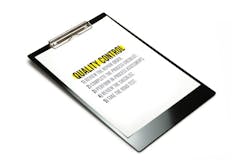Creating a Quality-Control Process
Al Waller, general manager of Louisiana-based Fradella’s Collision Centers, once had 14 percent of production volume that needed to be reworked for some type of imperfection. Those comebacks created significant additional costs, efficiency losses, time management issues and customer satisfaction problems. That was before Waller implemented a simple quality-control process that he says can be replicated at any shop.
Shops will never be perfect, but they can astronomically reduce their comeback frequency by implementing a quality-control process. We’ve been using a very basic, straight-forward quality control process for roughly 25 years that any shop location can easily implement today. It consists of the following five steps:
1. Review the repair order. In our shop, the person who writes estimates is called the repair process manager (RPM). It doesn’t matter what you call the position; any shop can do this with their current estimator. They review the estimate and assess whether every necessary item was transferred to the repair order—a document that includes the final descriptions of work that will be performed. The RPM reviews that information directly with the technician so everyone clearly understands what work the customer agreed to, and what the technician’s responsibilities are to make the repair.
2. Complete a process checklist. We created a generic quality control checklist that technicians complete during the repair process. The purpose is to assign accountability to each technician who works on the vehicle by verifying that they’ve performed certain operations.
The checklist is a one-page document split into three departments—body, paint and detail. It includes key processes that technicians in each department must complete for every repair. Each department has its own set of items that must be checked off on every job. The checklist includes items such as seam sealer application, disconnection and reconnection of lights, alignment of lights, mechanical operations, checking for panel dents, undercoating application, corrosion protection application, checking dash lights, identifying water leaks or wind noises, and removal of overspray.
The checklist is stored on the dash of every vehicle so technicians are able to verify that all necessary items have been addressed as the repair process continues.
3. Perform in-process assessments. The RPM regularly looks at every car as jobs move through the repair process. The RPM never walks past a car without looking it over, and always assesses jobs before they move to the next department. For example, the RPM always looks at jobs when the body department is finished before moving it to the paint department. That helps identify any imperfections that will cause delays in the paint booth, and prevents moving vehicles backward during the process. In addition, if you inspect vehicles right after they come out of the spray booth, you can immediately identify whether any nibs, sags, runs or color match problems exist. You’re able to take care of those things right away, rather than when the customer is waiting in your lobby. The RPM spends just a couple minutes assessing vehicles roughly five separate times throughout the repair. Overall, it requires about 20 minutes of time for each job.
It’s extremely important to have a manager inspecting vehicles throughout the repair and communicating with the people who are doing the work. Implementing that step alone will make a huge positive difference in any shop in terms of rework and unsatisfied customers. If you do this throughout the process, the time you need to spend assessing vehicles at the end is significantly reduced.
4. Review the checklist. At the end of the repair, the RPM assesses the technician checklist in its entirety. They compare the checklist to the car, and sign-off on each item to verify that it was completed with proper quality and accuracy before scheduling the delivery.
5. Take a road test. Take every vehicle for a test drive following completion of the repair. Make sure the car handles properly if you made any frame repairs, and listen for wind noises caused by air leaks if you made adjustments to any doors or seals. Don’t just drive the car around the block. Drive the car several miles to incorporate different speeds and road conditions to ensure there are no problems.
Make sure to allow ample time for the quality-control process, especially steps four and five. Shops commit to have cars ready by a certain time, but, in many situations, technicians work on final repairs right up to the time when customers show up. The quality-control process goes out the window in those situations. It’s either done too quickly or doesn’t get done at all. When scheduling deliveries, give yourself some padding room at the end to thoroughly look everything over one final time. That way nobody needs to scramble to make last-minute adjustments.
This isn’t a complicated or time-consuming process. It’s just a matter of visually inspecting vehicles and physically testing them before customers pick them up. The key is to be disciplined about doing this on every job, and to make it a foundation of your business.
